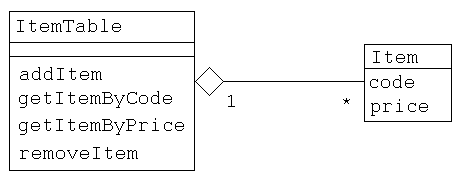
chat channel
joafip users mailing list
forums
This page is to give you an idea how simple it is to use JOAFIP to create your own database.
We are going to learn how to open, store, retrieve, update and delete instances of a record entity class stored on a persistent table entity. In our example the record entity will be an Item whose attributes are the item code and price.
In fact it is only a data model instance in memory that will be persisted.

Relation
composition between ItemTable and Item is realized using
PTreeMap
other collection
usable for multiple cardinality relation
A simple class with to members: code and price.
/**
*
item entity<br>
*
comparable compare item code ( the main key )
*/
public
class Item implements Comparable<Item> {
/** item code is immutable : it is
the main
key */
private
final String code;
/**
the item price */
private
BigDecimal price;
public
Item(final String code) {
super();
this.code = code;
}
public
Item(final String code, final BigDecimal price) {
super();
this.code
= code;
this.price
= price;
}
public BigDecimal getPrice() {
return price;
}
public
void setPrice(final BigDecimal price) {
this.price = price;
}
public
String getCode() {
return code;
}
@Override
public
int compareTo(final Item otherItem) {
//
/!\ JOAFIP persistable
object rule
//
do not use code.compareTo(otherItem.code)
//
see joafip persistent
pojo
//
or use joafip 3.0.0 java
agent
return
code.compareTo(otherItem.getCode());
}
@Override
public
String toString() {
return code + ";" + price + ";";
}
}
The item table that will be persisted.
public
class
ItemTable {
/**
map of {@link Item} by item code */
private final Map<String,
Item>
itemByCodeMap =
/**/new
PTreeMap<String, Item>();
/**
map of {@link Item} by item price, can have multiple item for same
price
*/
private
final NavigableMap<BigDecimal, Set<Item>>
itemByPrice =
/**/new PTreeMap<BigDecimal, Set<Item>>();
public Item addItem(final Item
item) {
final
Item previousItem =
itemByCodeMap.put(item.getCode(), item);
if
(previousItem != item)
{// NOPMD must compare object instance
removeOfPriceMap(previousItem);
addToPriceMap(item);
}
return
previousItem;
}
public
Item getItemByCode(final String itemCode) {
return
itemByCodeMap.get(itemCode);
}
public
Collection<Item> getAllItem()
{
return
itemByCodeMap.values();
}
public List<Item>
getItemByPrice(final BigDecimal fromPrice, final BigDecimal toPrice) {
final
NavigableMap<BigDecimal,
Set<Item>> subMap = itemByPrice
.subMap(fromPrice, true/*
fromInclusive */,
toPrice, true/* toInclusive */);
final
List<Item> list
= new PLinkedList<Item>();
for (Set<Item> set :
subMap.values())
{
list.addAll(set);
}
return
list;
}
public
Item removeItem(final String itemCode) {
final
Item removed =
itemByCodeMap.remove(itemCode);
removeOfPriceMap(removed);
return
removed;
}
private
void addToPriceMap(final Item toAdd) {
final BigDecimal price =
toAdd.getPrice();
Set<Item> set =
itemByPrice.get(price);
if (set == null) {
set =
new PTreeSet<Item>();
itemByPrice.put(price,
set);
}
set.add(toAdd);
}
private
void removeOfPriceMap(final Item toRemove) {
if
(toRemove != null) {
final BigDecimal price = toRemove.getPrice();
final
Set<Item> set =
itemByPrice.get(price);
if
(set != null) {
set.remove(toRemove);
}
}
}
}
To access a storage file or create a new file persistence manager providing the path to your storage file as the parameter. The data access session is the facade to manage object in storage file. Closing the file persistence with the #close() method will close the storage file and release all resources associated with it.
since
4.0.0
before
4.0.0
open the session for CRUD operation ( Create Read Update Delete ).
session.open();
close session saving mode to replicate change in memory to storage file.
session.close(EnumFilePersistenceCloseAction.SAVE);
in case of read only access, close session not replicate change in memory to storage file, this can be a kind of rollback.
session.close(EnumFilePersistenceCloseAction.DO_NOT_SAVE);
store ItemTable class instance
/*
store new
item table (empty) */
session.open();
ItemTable
itemTable = new ItemTable();
session.setObject("itemTable",
itemTable);
session.close(EnumFilePersistenceCloseAction.SAVE);
add Item class instance to stored ItemTable instance will persist these Item object
/*
populate
item table */
session.open();
itemTable
= (ItemTable) session.getObject("itemTable");
Item
item = new Item("123", 10);
itemTable.addItem(item);
item
= new Item("456", 10);
itemTable.addItem(item);
item
= new Item("789",
11);
itemTable.addItem(item);
session.close(EnumFilePersistenceCloseAction.SAVE);
Joafip have not queering system, but ItemTable implement all that is need to retrieve object: all goes with accessor methods.
/*
retrieve by
code */
session.open();
itemTable
= (ItemTable) session.getObject("itemTable");
item
= itemTable.getItemByCode("456");
//
_log.info("retrieved by code 456: " + item);
item
= (Item) filePersistence.copy(item);// create accessible out of
session deprecated
in
3.0.0
item = (Item)
filePersistence.deepCopy(item);// create accessible out of
session
session.close(EnumFilePersistenceCloseAction.DO_NOT_SAVE);
//
item is accessible out of data access session
_log.info("retrieved
by code 456:" + item);
Updating objects is just as easy as get object in memory, call modifier method, and then close data access session saving.
/*
update
*/
session.open();
itemTable
= (ItemTable) session.getObject("itemTable");
item
=
itemTable.getItemByCode("123");
item.setPrice(9);
session.close(EnumFilePersistenceCloseAction.SAVE);
Deleting objects is just as easy as for update.
/*
delete
*/
session.open();
itemTable = (ItemTable)
session.getObject("itemTable");
item =
itemTable.removeItem("456");
_log.info("deleted "
+ item);
session.close(EnumFilePersistenceCloseAction.SAVE);
More
complex query
can be added by adding accessor/modifier methods to ItemTable
class.
It is possible to create a DataBase class that is a
composition of multiple tables. This DataBase class can act as a
facade to store, retrieve, update and delete data entity. This facade
can implement a set of method for complex queries, all in java
navigating in object graph constituted of table of data entity.
get
full sources
